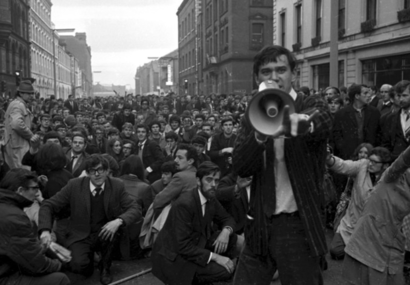Black Revolution
| Black Revolution | ||||
|---|---|---|---|---|
| Part of Gjorkan Resistance | ||||
 A protest in Gjorka City following Tannerburg's announcement | ||||
| Date | September 3, 1971 - November 11, 1972 | |||
| Location | ||||
| Caused by |
| |||
| Goals |
| |||
| Methods | Protests, Riots, Demonstrations | |||
| Resulted in | Restoration of Gjorkan Democracy | |||
| Parties to the civil conflict | ||||
| Lead figures | ||||
| Number | ||||
| ||||
| Casualties and losses | ||||
| ||||
The Black Revolution were a series of demonstrations in Gjorka following the 1971 Gjorkan coup d'état, and Austin Tannerburg's announcement of the return of Gjorkan democracy. Following this announcement, protesters around Gjorka flooded the streets in celebration. Military Units had been mobilizing in response to Tannerburg's coup to perform a counter-coup however following his announcement mass desertions followed causing them to disband. Tannerbug initially attempted to suppress these protests as he had no actual intention of restoring democracy since it was simply a ploy to prevent a counter-coup. However, the sheer magnitude of protestors forced Tannerburg to concede and allow for a transition period to take place. On November 11, 1972 the Third Gjorkan Republic was declared, and democracy was restored to Gjorka.
Contents
Background
Gjorka had been ruled by a dictatorship for over a hundred years. From 1850 to 1918, the First Gjorkan Republic ruled as an oligarchical dictatorship. In 1911, the Blue Revolution occurred where pro-democracy protestors (primarily marking themselves with blue flags) attempted to overthrow the government. They succeeded in securing Gjorka City, but the High Court escaped leading to the Second Gjorkan Civil War. The war initially began as a fight between the loyalist government and a general pro-democracy coalition. However in 1917, the Revolutionary government was overthrow and replaced by a military government leading to the creation of a rival socialist government. The Revolutionary government emerged victorious in the war, and established the Second Gjorkan Republic, another dictatorship.
Despite the surrender of the loyalist and socialist governments, several groups refused to give up the fight. The Gjorkan Republican Army (APG) made up of loyalists, and the Army of the Proletariat (ANP) made up of socialists were the primary paramilitaries continuing the fight. This early period of what eventually became know as the Gjorkan Resistance was called the War Against Socialism. However, in 1923 when President Éamon de Valera announced elections would be suspended indefinitely the resistance expanded in a broader anti-government movement. More paramilitary groups entered the fight including the right wing Golden Dawn, the hardline communist Front for the Liberation of Gjorka (AHSG), the Democratic Coalition of Gjorka (CDG), and the Gjorkan Liberation Army (AFG) which was made up of former leftwing members of the APG who broke away.
The resistance lasted for 53 years from 1919 to 1972, and saw tremendous death and destruction. The Military Government cracked down brutally on revolutionary activity, and suppressed democratic ideas. Some historians estimate as many as 200,000 Gjorkans were killed over the decades in anti-government massacres. Some reform was offered during the rule of Eli Mannion who drew back much of the near total police state created by his predecessors. However, many of Mannion's reforms were undone when he was ousted by Caelan MacRory. This crackdown on free activities reignited the resistance movement, particularly among young adults. The APG grew to become Gjorka's largest anti-resistance group led by Samuel MacMorrow who choose to focus more on civilian demonstrations than military actions as leader of the APG. In 1971, MacRory died leading to the formation of a transition government who planned to choose MacRory's successor. At the same time, protests and anti-governemnt actions were becoming more common place, as public disaffection with the dictatorship reached a critical point.
